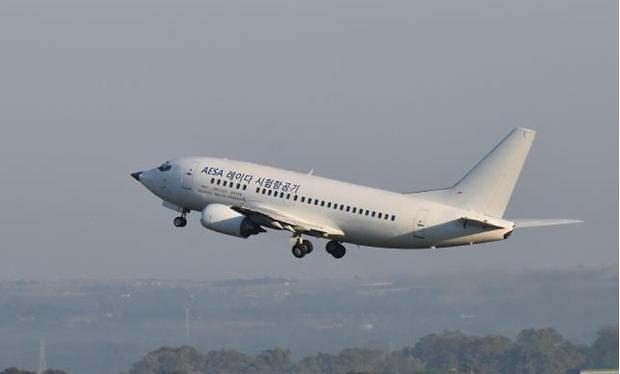
[Courtesy of Hanwha Systems]
SEOUL -- The first prototype of a computer-controlled array antenna system for South Korea's home-made KF-X fighter jet was unveiled as a result of strenuous research work that began in 2016 after the United States refused to transfer sensitive core technologies such as radar steal function. Developers were lauded for acquiring independent technologies.
The prototype of the Active Electronically Scanned Array (AESA) system was showcased in a ceremony sponsored by the Defense Acquisition Program Administration (DAPA), a defense ministry-controlled state body in charge of arms acquisition, at the research center of Hanwha Systems, a provider of defense products and technologies, in Yongin, 35 kilometers (22 miles) south of Seoul.
Along with the Agency for Defense Development, a state agency for research and development in defense technology, Hanwha has been involved in the development of core KF-X components such as AESA that can electronically steer the beam of radio waves to point in different directions. AESA radars can spread signal emissions across a wider range of frequencies, allowing aircraft to radiate powerful radar signals while still remaining stealthy.
US companies such as Lockheed Martin and General Electrics were involved in the KF-X project, but Washington has been reluctant to transfer key technologies for stealth fighters and an advanced radar system, prompting South Korea to acquire related technologies independently or through cooperation with other foreign companies.
The AESA prototype has been sent to ELTA Systems, an Israeli provider of defense products, for ground and flight tests, DAPA said in a statement. "We are pleased to see the first prototype of the AESA radar today, and with confidence, we ask all developers to make unwavering efforts to ensure that our AESA radar can reach a level perfect for KF-X fighter jets," ADD head Nam Sae-kyu was quoted as saying.
A KF-X fighter jet installed with the AESA system will be released in the first half of next year, DAPA said. "We hope that the AESA radar will be successfully integrated into KF-X so that it can demonstrate its competitiveness in the global market," Choi Ho-cheon, a senior DAPA official, said, praising efforts by ADD and Hanwha researchers to acquire technologies foreign companies are reluctant to transfer.
Hanwha and ADD are involved in the development of automatic terrain-following (TF) and terrain avoidance (TA) technology that allows high-tech aircraft to make detection by enemy radar more difficult by flying low and safe along the terrain.
In October 2019, Korea Aerospace Industries (KAI), the country's sole aircraft maker, showcased the actual model of KF-X along with an operational weapons system at a defense exhibition in Seoul. The broad design of hardware and software has been completed, with component fabrication underway. The exterior is similar to F-35A stealth jets, but KAI said it costs about half less to operate and has better mobility.
The KF-X project is aimed at manufacturing 120 fighter jets that would replace South Korea's aging fleet of US-made F-4 and F-5 fighters. Specifications outlined by KAI showed that the fighter's maximum speed is Mach 1.81 with its range put at 2,900 kilometers (1,798 miles). With a maximum payload of 7,700 kilograms, 10 "pods" for missiles and fuel barrels are installed on the bottom of the fuselage and wings.
Copyright ⓒ Aju Press All rights reserved.




View more comments